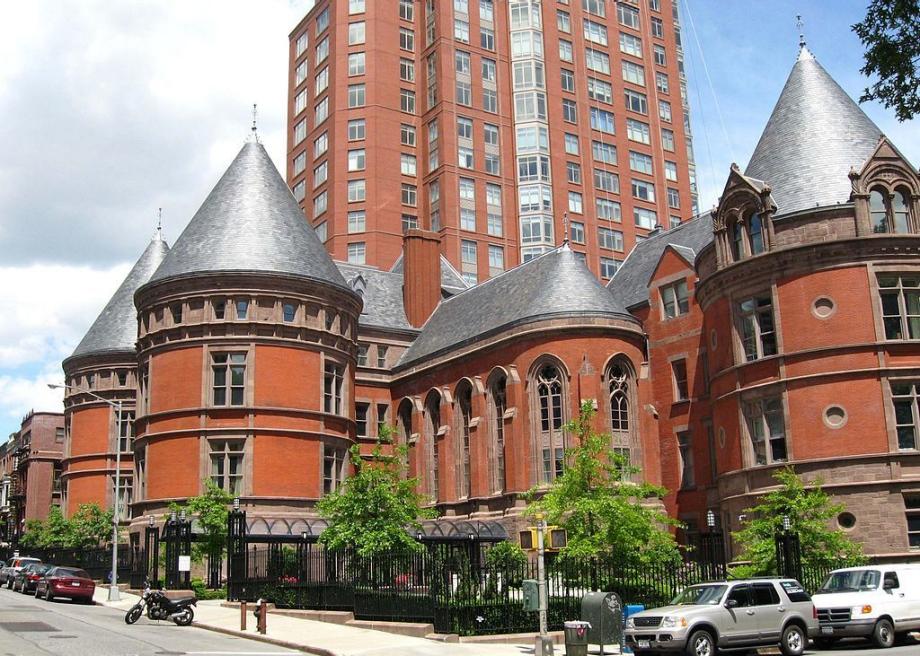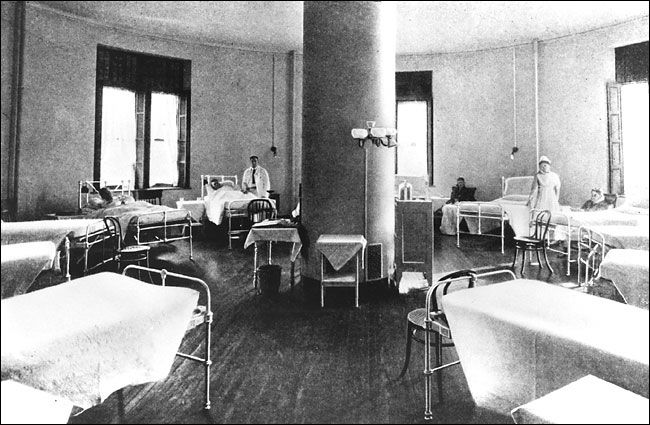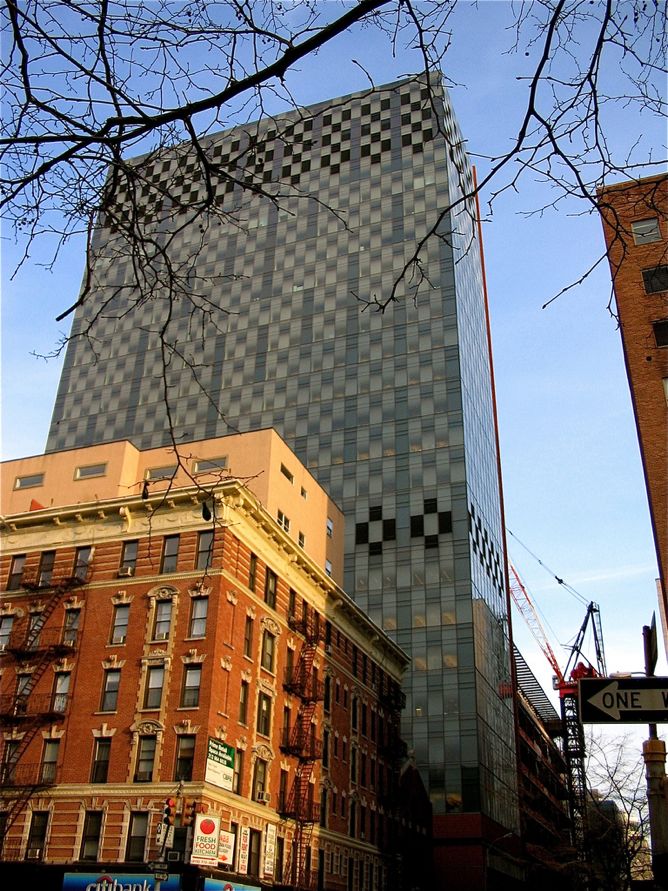Early Cancer Hospitals Were Modeled on French Castles, Served Champagne

Courtesy of Jim Henderson/Wikimedia Commons
Roman Mars’ podcast 99% Invisible covers design questions large and small, from his fascination with rebar to the history of slot machines to the great Los Angeles Red Car conspiracy. Here at The Eye, we cross-post new episodes and host excerpts from the 99% Invisible blog, which offers complementary visuals for each episode.
This week's edition—about the history of cancer hospitals—can be played below. Or keep reading to learn more.
On the southwest corner of Central Park West and 106th Street in New York City, there’s an enormous castle. It takes up the whole east end of the block, with its red brick cylindrical turrets topped with gleaming silver cones. All the stained glass windows and intricate stonework make the building looks like something out of a fairy tale.
This building’s past, however, is not very fairy tale–like at all.
When it was completed in 1887, this castle was the country’s first hospital devoted solely to cancer treatment. In the late 1800s, cancer was known to start as a tumor, but no one knew a whole lot beyond that.
In the back of the castle was a smokestack that used to lead out from the crematorium. That smokestack was smoking pretty often.
A lot of hospitals in the United States didn’t even want to treat cancer patients because they thought cancer was contagious. Also, hospitals had to publish their “death rates,” so they’d turn away patients who were likely to skew the numbers. This gave rise to tuberculosis hospitals and other specialty hospitals for diseases that were particularly deadly.
During and after the Civil War, American cancer patients would go to Europe, if they could afford it, since European doctors had developed more advanced forms of cancer treatment. Doctors from the United States would also go to Europe to study pathology and surgical techniques, and one such doctor, J. Marion Sims, wanted to bring some of these European cancer removal methods back to the United States.
Sims had previously worked at the New York Women’s Hospital, but in 1874 that hospital decided not to admit patients with cancer, because, for all they knew, cancer was fatally contagious. In 1887 Sims and a number of philanthropists established the first hospital exclusively devoted to cancer care: the castle at 455 Central Park West.
The building’s fairy tale–like appearance, it turns out, wasn’t unusual for hospitals of the time. These facilities were built like aristocratic mansions, with high walls, gatehouses, elaborate entries, and sometimes turrets, as a way of enticing wealthy patients.
In the late 1800s, hospitals were charitable institutions run by philanthropists, where poor people went for care. The wealthy mostly received care at home. Architect Charles Haight hoped the luxurious design would be a lure for paying customers, since this cancer hospital opened its doors to all patients, whether they could pay for care or not.
The big, round turrets that make the building look like a castle were actually wards that housed patients. The perfectly circular rooms were about 40 feet in diameter, and from an aerial view, the rooms looked like the face of clock, with beds around the perimeter. Doctors could easily make the rounds from bed to bed, and these circular rooms kept dirt from accumulating in corners.

Courtesy of Wikimedia Commons
Patients got plenty of fresh air, sunlight, and delicious food. There were even Champagne parties and carriage rides in Central Park to further entice paying customers. The building tried to make patients feel like they were going off to the French countryside, instead of a scary place where they would be subject to experimental cancer treatments and, quite possibly, die.
None of the medical staff really had any idea what they were doing. The main treatment for cancer at the time was surgery—namely, cutting people open and removing every lymph node possible while still keeping the patient alive.
This was also before the time of antibiotics, so a lot of patients died from infections after surgery. As late as 1920, only about 15 percent of patients survived a cancer diagnosis for more than two years. In 1900, the numbers were even lower (hence the on-site crematorium). Under that billowing smokestack, the New York Cancer Hospital soon earned a nickname: the Bastille. In trying to look like French château, the New York Cancer Hospital ended up feeling like a French prison. Despite a huge demand for cancer treatment, the hospital struggled financially and couldn’t attract patients.
In an attempt to get people in the door, the New York Cancer Hospital procured a controversial new form of medicine: radium. Radiation therapy, even more so than surgery, was completely unexplored, and a lot of doctors and care workers developed cancer themselves from handling the element.
It wasn’t until the 1930s that surgery improved and chemotherapy and other organized radiation treatments made cancer care very lucrative. In 1939, the cancer hospital left 455 Central Park West for the Upper East Side, where it became Memorial Sloan Kettering, which is now known as one of the best hospitals for cancer treatment in the U.S.

Courtesy of Wladimir Labeikovsky/Flickr
Now, of course, hospitals don’t look like castles anymore. After World War I, hospitals started to look like small civic institutions such as city halls or schools, with block-like units. Paying patients could expect single rooms, and nonpaying patients could be put in a double or quadruple room. Instead of investing in gourmet food, Champagne, and carriage rides, hospitals channeled money into surgical suites and mechanical equipment. Wooden beds and dressers disappeared, and instead all furnishings were metal and carried an air of efficiency.
After World War II, office building became the models for skyscraper-like hospitals. After the 1980s, hospitals started to look like shopping malls, with just one or two floors of big open spaces.
Hospitals have largely done away with circular rooms, but the general idea of easy-to-clean rounded corners has actually persisted. If you visit a hospital today, look at where the wall meets the floor. It’s probably curved, so that nothing can get stuck in the right angle between the wall and the floor.
The Central Park West castle went through a dark period in the mid-1950s, when it became a notoriously roach-infested, abusive nursing home. Towers Nursing Home was shut down in the 1970s, and the building sat vacant and in a state of disrepair throughout the 1980s.
Today, in 21st-century Manhattan, even a haunted old hospital can become expensive housing. The castle has been turned into 17 round, light-filled condo units, complete with a parking garage, spa, pool, and fitness center. Finally, after 100 years of imitating upscale real estate, the castle on the park finally is actually what its always wanted to be: a nice place for rich people.
To learn more, check out the 99% Invisible post or listen to the show.
99% Invisible is distributed by PRX.
